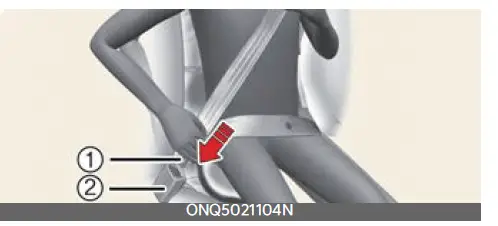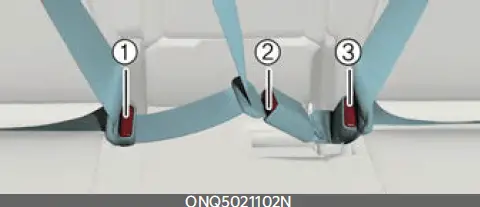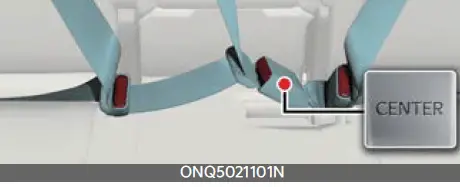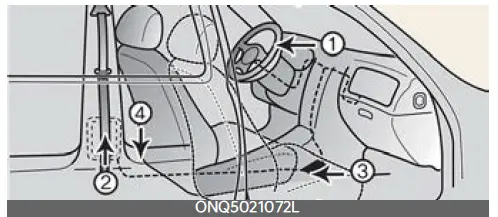Kia Sportage PHEV 2023 Seat Belts
With its full set of advanced safety features, the 2023 Kia Sportage PHEV stands out as a reliable guardian of passenger well-being in a world where car safety is always changing. At the heart of this dedication to passenger safety is the simple but necessary seat belt, an important part of car safety that has been around for generations. In the 2023 Sportage PHEV, seat belts are not just safety features; they are important lifelines that have been carefully designed to protect everyone inside. These seat belts are designed to be both useful and comfortable. They are like a silent guardian, ready to keep people safe on any trip, from a short commute to a cross-country trip. As we begin this in-depth look, we’ll be breaking down the 2023 Kia Sportage PHEV’s seat belts and showing how important they are for the safety and peace of mind of everyone who drives this forward-thinking and environmentally-friendly car.
2023 KIA SPORTAGE Specs, Price, Features and Mileage (Brochure)
Seat belts
Seat belts are designed to bear upon the bony structure of the body, and should be worn low across the front of the pelvis, chest and shoulders.
Seat belt restraint system
For maximum restraint system protection, the seat belts must always be used whenever the vehicle is moving.
- A properly positioned shoulder belt should be positioned midway over your shoulder, across your collarbone.
- Never allow children to ride in the front passenger seat.
WARNING
Twisted seat belt
Make sure your seat belt is not twisted when worn. A twisted seat belt may not properly protect you in an accident and could even cut into your body.
WARNING
Shoulder Belt
- Never wear the shoulder belt under your arm or behind your back. An improperly positioned shoulder belt cannot protect the occupant in the event of a crash.
- Always wear both the shoulder portion and lap portion of the lap/shoulder belt.
WARNING
Damaged seat belt
Any damage in webbing or hardware may lead to serious injury or death in a crash. For your safety, replace the entire seat belt assembly when any part of the webbing or hardware is damaged.
Seat belts are designed to bear upon the bony structure of the body, and should be worn low across the front of the pelvis, chest and shoulders, as applicable; wearing the lap section of the belt across the abdominal area must be avoided.
Seat belts should be adjusted as firmly as possible, consistent with comfort, to provide the protection for which they have been designed.
A slack belt will greatly reduce the protection afforded to the wearer.
Care should be taken to avoid contamination of the webbing with polishes, oils and chemicals, and particularly battery acid. Cleaning may safely be carried out using mild soap and water. The belt should be replaced if the webbing becomes frayed, contaminated or damaged.
- No modifications or additions should be made by the user which would either prevent the seat belt from adjusting
- When you fasten the seat belt, be careful not to latch the seat belt in the buckles of other seats. It is very dangerous and you may not be protected by the seat belt properly.
- Do not unfasten the seat belt and do not fasten and unfasten the seat belt repeatedly while driving. This could result in loss of control, and an accident causing death, serious injury, or property damage.
- When fastening the seat belt, make sure that the seat belt does not pass over objects that are hard or can break easily.
WARNING
Seat belt buckle
Do not allow foreign material (gum, crumbs, coins, liquids, etc.) to obstruct the seat belt buckle. This may prevent the seat belt from fastening securely.
Seat belt warning
The seat belt warning light and warning chime operate under the following conditions.
Driver’s seat belt warning
As a reminder to the driver, the seat belt warning light will appear for approximately 6 seconds each time you turn the ENGINE START/STOP button ON regardless of belt fastening. If the seatbelt is not fastened, the warning chime will sound for about 6 seconds.
If you start to drive without the seat belt fastened over approximately 5 mph (9 km/h) and less than approximately 12 mph (20 km/h), the corresponding warning light will appear. The warning light will turn off when the vehicle speed drops below approximately 5 mph (9 km/h).
If you start to drive without the seat belt fastened or you unfasten the seat belt when you drive approximately 12 mph (20 km/h) and faster, the warning light will blink and a warning chime will sound for approximately 100 seconds. When the seat belt is unfastened during driving, the warning light will appear when the speed is under approximately 12 mph (20 km/h). When the speed is approximately 12 mph (20 km/h) and faster, the warning light will blink and a warning chime will sound for approximately 100 seconds.
Front passenger’s seat belt warning
As a reminder to the front passenger, the seat belt warning light will appear for approximately 6 seconds each time you turn the ENGINE START/STOP button ON regardless of belt fastening. If you start to drive without the passenger seat belt fastened when you drive over approximately 5 mph (9 km/h) and less than approximately 12 mph (20 km/h), the corresponding warning light will appear. The warning light will turn off when the vehicle speed drops approximately below 5 mph (9 km/h).
If you start to drive without the passenger seat belt fastened or you unfasten the seat belt when you drive approximately 12 mph (20 km/h) and faster, the warning light will blink and a warning chime will sound for approximately 100 seconds. When the passenger seat belt is unfastened during driving, the warning light will appear when the speed is approximately under 12 mph (20 km/h). When the speed is approximately 12 mph (20 km/h) and faster, the warning light will blink and a warning chime will sound for approximately 100 seconds.
NOTICE
- Even if the front passenger seat is not occupied, the seat belt warning light will appear for approximately 6 seconds.
- The front passenger’s seat belt warning may operate when luggage is placed on the front passenger seat.
- Rear passenger’s seat belt warning

- Rear seat: (1) Driver’s side, (2) Center, (3) Passenger’s side
As a reminder to the rear passenger, the rear passenger’s seat belt warning lights will appear for approximately 6 seconds each time you turn the ENGINE START/STOP button ON regardless of belt fastening.
If you start to drive without the seat belt fastened or unfasten the seat belt when you drive under 12 mph (20 km/h), the corresponding warning light will continue to appear.
If you start to drive without the seat belt fastened or unfastened the seat belt when you drive over 12 mph (20 km/h) , the seat belt warning chime will sound for approximately 35 seconds and the corresponding warning light will blink.
When the seat belt is unfastened while driving, the warning light will appear when the speed is under 12 mph (20 km/h).
When the speed is 12 mph (20 km/h) and faster, the warning light will blink and a warning chime will sound for approximately 35 seconds.
NOTICE
Even if the front passenger seat is not occupied, the seat belt warning light will appear for approximately 6 seconds.
The rear side passenger’s seat belt warning may operate when luggage, laptop or other electronic device is placed on the rear side passenger seat.
For rear centre seat
As a reminder to the rear passenger, the rear passenger’s seat belt warning light will appear for approximately 6 seconds each time you turn the ENGINE START/STOP button ON regardless of belt fastening.
If the seat belt is not fastened when the ENGINE START/STOP button ON, the seat belt warning light will appear for approximately 70 seconds.
If you start to drive without the seat belt fastened or you unfasten the seat belt when you drive under 12 mph (20 km/h), the corresponding warning light will continue to appear for approximately 70 seconds.
If you continue to drive without the seat belt fastened or you unfasten the seat belt when you drive over 12 mph (20 km/h), the seat belt warning chime will sound for approximately 35 seconds and the corresponding warning light will blink.
If the rear door is opened or closed under 6 mph (10 km/h), warning light and warning sound does not work even if driving over 12 mph (20 km/h).
Seat belt – Driver’s 3-point system with emergency locking retractor
The following explains how to fasten and adjust the driver’s seat belt.
Fastening the your seat belt
- Pull it out of the retractor and insert the metal tab (1) into the buckle (2).
There will be an audible “click” when the tab locks into the buckle.
WARNING
You should place the lap belt portion as low as possible and snugly across your hips. If the lap belt is located too high on your waist, it may increase the chance of injury in the event of a collision.
The arm closest to the seat belt buckle should be over the belt while the other arm should be under the belt as shown in the illustration. Never wear the seat belt under the arm closest to the door.
The seat belt automatically adjusts to the proper length only after the lap belt portion is adjusted manually so that it fits snugly around your hips. If you lean forward in a slow, easy motion, the belt will extend and let you move around. If there is a sudden stop or impact, however, the belt will lock into position. It will also lock if you try to lean forward too quickly.
NOTICE
If you are not able to pull out the seat belt from the retractor, firmly pull the belt out and release it. Then you will be able to pull the belt out smoothly.
Adjusting the height of the shoulder belt
You can adjust the height of the shoulder belt anchor to one of the 4 positions for maximum comfort and safety.
The height of the adjusting seat belt should not be too close to your neck. The shoulder portion should be adjusted so that it lies across your chest and mid-way over your shoulder near the door and not your neck.
To adjust the height of the seat belt anchor, lower or raise the height adjuster into an appropriate position.
- To raise the height adjuster, pull it up (1).
- To lower it, push it down (3) while pressing the height adjuster button (2).
Release the button to lock the anchor into position. Try sliding the height adjuster to make sure that it has locked into position.
Improperly positioned seat belts can cause serious injuries in an accident.
WARNING
Shoulder belt positioning
Verify the shoulder belt anchor is locked into position at the appropriate height. Never position the shoulder belt across your neck or face. Improperly positioned seat belts can cause serious injuries in an accident.
WARNING
Seat belt replacement
Replace your seat belts after being in an accident. Failure to replace seat belts after an accident could leave you with damaged seat belts that will not provide protection in the event of another collision.
Seat belts – Front passenger and rear seat 3-point system with combination locking retractor
The following explains how to fasten the passenger’s and rear seat belts.
Fastening your seat belt:
Combination retractor-type seat belts are installed in the rear seat positions to help accommodate the installation of Child Restraint System. Although a combination retractor is also installed in the front passenger seat position, it is strongly recommended that children always be seated in the rear seat. NEVER place any infant restraint system in the front seat of the vehicle.
This type of seat belt combines the features of both an emergency locking retractor seat belt and an automatic locking retractor seat belts.
- Pull it out of the retractor and insert the metal tab into the buckle. There will be an audible “click” when the tab locks into the buckle. When not securing a child restraint, the seat belt operates in the same way as the driver’s seat belt (emergency locking retractor type).
It automatically adjusts to the proper length only after the lap belt portion of the seat belt is adjusted manually so that it fits snugly around your hips.
When the seat belt is fully extended from the retractor to allow the installation of a Child Restraint System, the seat belt operation changes to allow the belt to retract, but not to extend (automatic locking retractor type).
NOTICE
Although the combination retractor provides the same level of protection for seated passengers in either emergency or automatic locking modes, have the seated passengers use the emergency locking feature for improved convenience. The automatic locking function is intended to facilitate child restraint installation. To convert from the automatic locking feature to the emergency locking operation mode, allow the unbuckled seat belt to fully retract.
CAUTION
Do NOT fold down the left portion of the rear seatback when the rear centre seat belt is buckled. ALWAYS UNBUCKLE the rear center seat belt before folding down the left portion of the rear seatback. If the rear center seat belt is buckled when the left portion of the rear seatback is folded down, distortion and damage to the top portion of the seatback and seat belt garnish may result, causing the seatback to lock into the folded down position.
The seat belt should be locked into the buckle on each seat cushion to be properly fastened.
- Rear right seat belt fastening buckle
- Rear center seat belt fastening buckle
- Rear left seat belt fastening buckle
WARNING
Prior to fastening the rear seat belts, ensure the latch matches the seat belt buckle. Forcefully fastening the left or right seat belt to the center buckle can result in an improper fastening scenario that will not protect you in an accident.
When using the rear center seat belt, the buckle with the “CENTER” mark must be used.
Stowing the rear seat belt
The rear seat belt buckles can be stowed in the pocket between the rear seatback and cushion when not in use.
- Route the seat belt webbing through the rear seat belt guides. It will help keep the belts from being trapped behind or under the seats.
- After inserting the seat belt, tighten the belt webbing by pulling it up
CAUTION
When pulling out to wear the seat belt, the tongue should be slowly pulled out of the seat belt guide so that the seat belt guide does not come off the trim.
Releasing the seat belt
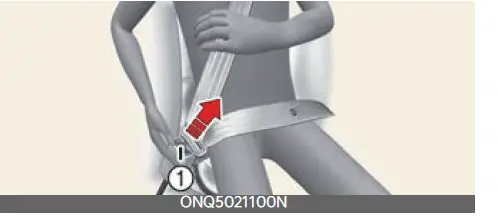
- The seat belt is released by pressing the release button (1) on the locking buckle.
When it is released, the belt should automatically draw back into the retractor.
If this does not happen, check the belt to make sure it is not twisted, then try again.
Pre-tensioner seat belt
Your vehicle is equipped with driver’s pre-tensioner seat belts (retractor pre-tensioner and EFD (Emergency Fasten-ing Device)).

The pre-tensioner seat belts may be activated, when a frontal collision is severe enough, together with the air bags.
When the vehicle stops suddenly, or if the occupant tries to lean forward too quickly, the seat belt retractor may lock into position. In certain frontal collisions, the pre-tensioner will activate and pull the seat belt into tighter contact against the occupant’s body.
- Retractor Pre-tensioner
The purpose of the retractor pre-tensioner is to make sure that the shoulder belts fit in tightly against the occupant’s upper body in certain frontal collisions. - EFD (Emergency Fastening Device)
The purpose of the EFD is to make sure that the pelvis belts fit in tightly against the occupant’s lower body in certain frontal collisions.
If the system senses excessive tension on the driver or passenger’s seat belt when the pre-tensioner system activates, the load limiter inside the retractor pre-tensioner will release some of the pressure on the affected seat belt.
NOTICE
When the pre-tensioner seat belts are activated, a loud noise may be heard and fine dust, which may appear to be smoke, may be visible in the passenger compartment. These are normal operating conditions and are not hazardous.
The seat belt pre-tensioner system consists mainly of the following components. Their locations are shown in the illustration:
- The actual position of seat belt pre-tensioner system components may differ from the illustration.
- SRS airbag warning light
- Retractor pre-tensioner assembly 3 SRS control module
- Emergency fastening device (EFD)
WARNING
Skin Irritation
Wash all exposed skin areas thoroughly after an accident in which the pre-tensioner seat belts were activated. The fine dust from the pre-tensioner activation may cause skin irritation and should not be inhaled for prolonged periods.
NOTICE
- Both the driver’s and front passenger’s seat belt pre-tensioner systems may be activated not only in certain frontal collisions but also in certain side collisions or rollovers if the vehicle is equipped with a side or curtain airbag.
- Because the sensor that activates the SRS air bag is connected with the pre-tensioner seat belt, the SRS air bag warning light on the instrument panel will appear for approximately 6 seconds after the ignition switch has been turned to the ON position, and then it should turn off.
- If the pre-tensioner seat belt system is not working properly, this warning light will appear even if there is not malfunction with the SRS airbag. If the SRS airbag warning light does not appear when the ignition switch has been turned to the ON position, or if it remains illuminated after appearing for approximately 6 seconds, or if it appears while the vehicle is being driven, have an authorized Kia dealer inspect the pre-tensioner seat belt and SRS air bag system as soon as possible.
NOTICE
Do not attempt to service or repair the pre-tensioner seat belt system in any manner. Do not attempt to inspect or replace the pre-tensioner seat belts yourself. This must be done by an authorized Kia dealer.
WARNING
Hot pre-tensioner
Do not touch the pre-tensioner seat belt assemblies for several minutes after they have been activated. When the pre-tensioner seat belt mechanism fires during a collision the pre-tensioner becomes hot and can burn you.
Pre-tensioners are designed to operate only one time. After activation, pre-tensioner seat belts must be replaced. If the pre-tensioner must be replaced, contact an authorized Kia dealer.
2023 KIA SPORTAGE Specs, Price, Features and Mileage (Brochure)
Seat belt precautions
Take the following precautions when using seat belts.
Infant or small child
All 50 states have child restraint laws. You should be aware of the specific requirements in your state. Child and/or infant seats must be properly placed and installed in the rear seat.
NOTICE
Small children are best protected from injury in an accident when properly restrained in the rear seat by a Child Restraint System that meets the requirements of the Federal Motor Vehicle Safety Standards (FMVSS). Before buying any Child Restraint System, make sure that it has a label certifying that it meets Federal Motor Vehicle Safety Standard 213. The restraint must be appropriate for your child’s height and weight. Check the label on the child restraint for this information.
Larger children
Children who are too large for the Child Restraint System should always occupy the rear seat and use the available lap/shoulder belts. The lap portion should be fastened and snug on the hips as low as possible. Check periodically to ensure that the belt fits. A child’s squirming could put the belt out of position. Children are given the most safety in the event of an accident when they are restrained by a proper restraint system in the rear seat. If a larger child (over age 13) must be seated in the front seat, the child should be securely restrained by the available lap/shoulder belt and the seat should be placed in the rearmost position. Children age 13 and under should be restrained securely in the rear seat. NEVER place a child age 13 and under in the front seat. NEVER place a rear-facing child seat in the front seat of a vehicle.
If the shoulder belt portion slightly touches the child’s neck or face, try placing the child closer to the centre of the vehicle. If the shoulder belt still touches their face or neck they need to be returned to a Child Restraint System.
WARNING
Small children
Do not allow small children to ride in the vehicle without an appropriate Child Restraint System. If the shoulder belt comes in contact with your child’s neck or face, your child is too small to ride in the vehicle. In a crash, the seat belt will inflict injury to your child’s neck, throat and face.
Restraint of pregnant women
Pregnant women should wear lap/shoulder belt assemblies whenever possible according to specific recommendations by their doctors. The lap portion of the belt should be worn AS SECURELY AND LOW AS POSSIBLE
WARNING
Pregnant women
Pregnant women must never place the lap portion of the seat belt above or on the abdomen where the fetus is located. The force of the seat belt during a collision will crush the fetus.
Injured person
A seat belt should be used when an injured person is being transported. When this is necessary, you should consult a physician for recommendations.
One person per belt
Two people (including children) should never attempt to use a single seat belt. This could increase the severity of injuries in case of an accident.
Do not lie down
To reduce the chance of injuries in the event of an accident and to achieve maximum effectiveness of the restraint system, all passengers should be sitting up and the front and rear seats should be in an upright position when the vehicle is moving. A seat belt cannot provide proper protection if the person is lying down in the rear seat or if the front and rear seats are in a reclined position.
Care of seat belts
Seat belt systems should never be disassembled or modified. In addition, care should be taken to ensure that seat belts and belt hardware are not damaged by seat hinges, doors or other abuse.
WARNING
Pinched seat belt
Make sure that the webbing and/or buckle does not get caught or pinched in the rear seat when returning the rear seat back to its upright position. A caught or pinched webbing/buckle may become damaged and could fail during a collision or sudden stop.
WARNING
Seatbelts can become hot in a vehicle that has been closed up in sunny weather. Please handle with care, as they could burn infants and children if used abruptly.
Periodic inspection
All seat belts should be inspected periodically for wear or damage of any kind. Any damaged parts should be replaced as soon as possible.
Keep belts clean and dry
Seat belts should be kept clean and dry. If belts become dirty, they can be cleaned by using a mild soap solution and warm water. Bleach, dye, strong detergents or abrasives should not be used because they may damage and weaken the fabric.
When to replace seat belts
The entire in-use seat belt assembly or assemblies should be replaced if the vehicle has been involved in an accident. This should be done even if no damage is visible. Additional questions concerning seat belt operation should be directed to an authorized Kia dealer.
FAQ
A: The 2023 Kia Sportage PHEV typically has seat belts for five passengers.
A: Yes, many modern vehicles, including the Sportage PHEV, often feature height-adjustable seat belts to accommodate passengers of different sizes.
A: Yes, the rear seats are typically equipped with three-point seat belts, which provide both lap and shoulder restraints for added safety.
A: Seat belts are designed to restrain passengers in their seats and prevent them from being ejected from the vehicle in the event of a collision. They also help distribute the force of impact more evenly across the body to reduce the risk of injury.
A: Passengers should wear their seat belts low across their hips and snugly over their shoulders, with the lap belt resting across the upper thighs and the shoulder belt across the chest and shoulder.
A: Yes, it is crucial to wear seat belts for all trips, regardless of distance, as accidents can happen at any time.
A: Yes, many modern seat belts have a locking feature that engages during sudden stops or impacts to prevent excessive movement and provide added protection.
A: Yes, the Sportage PHEV typically features LATCH anchors for securing child safety seats.
A: Many vehicles, including the Sportage PHEV, are equipped with seat belt reminder systems that alert occupants to fasten their seat belts.
A: Passengers should promptly fasten their seat belts when the warning light or chime activates, as it indicates that one or more occupants are not properly secured.
A: Yes, passengers can adjust seat belts for comfort by using the seat belt adjusters located near the door pillars.
A: It’s a good practice to inspect seat belts regularly for signs of wear, such as fraying, cuts, or damaged buckles, and have them replaced if necessary.
A: Seat belts are typically covered by the vehicle’s limited warranty, but coverage may vary depending on the specific terms and conditions of the warranty.
A: Yes, each seat belt in the Sportage PHEV is designed to secure one passenger at a time.
A: Seat belts are designed for passenger safety and should not be used to secure cargo. Use appropriate tie-downs and cargo restraints for securing items in the vehicle.
Useful Link
View Full User Guide: Kia Sportage PHEV 2023 User Guide
Download Manuals: https://owners.kia.com/content/owners/en/manuals.html
2023 KIA SPORTAGE Specs, Price, Features and Mileage (Brochure)



